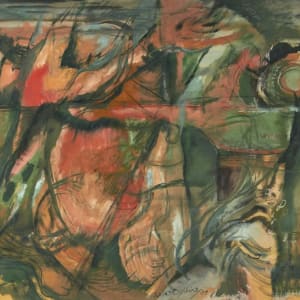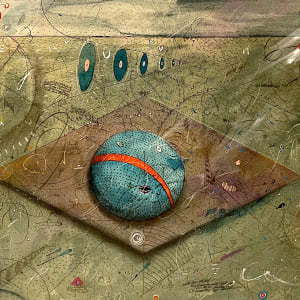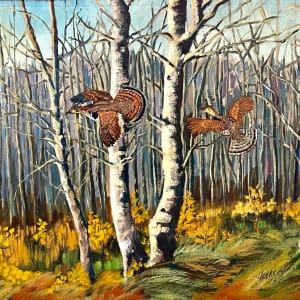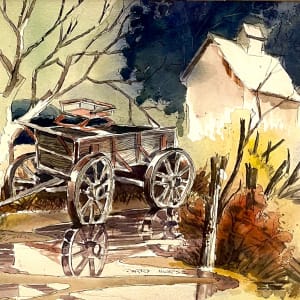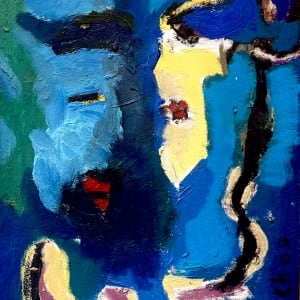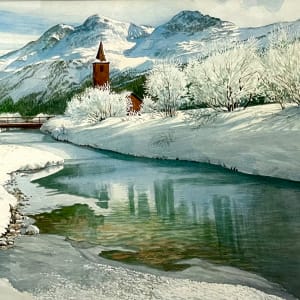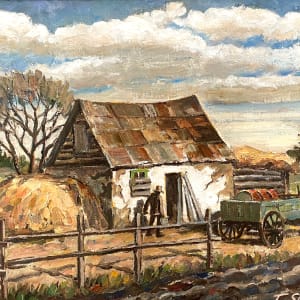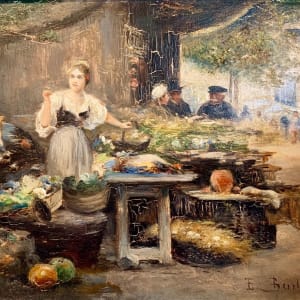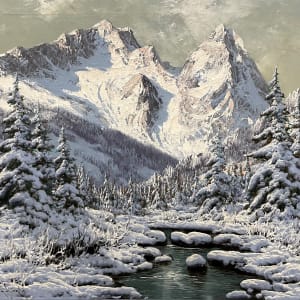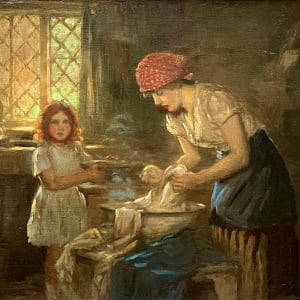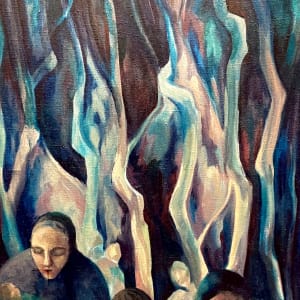Alan Collier (1911-1990)
Alan Collier (1911–1990) was a British-born Canadian artist, known for his work in painting, printmaking, and sculpture. He moved to Canada in the early 1930s, where he became an influential figure in the Canadian art scene. Collier was a key member of the Toronto-based Group of Seven, a collective of artists focused on depicting Canada's natural landscapes. His work often explored themes of Canadian identity, nature, and the intersection of abstraction and realism. Throughout his career, Collier exhibited widely and gained recognition for his distinctive style, blending European modernist influences with a deep appreciation for the Canadian wilderness.
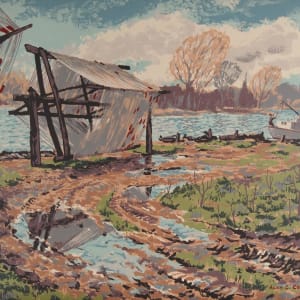
George Pepper (1903-1962)
Born in Ottawa, artist and educator Alexander John Pepper studied under J.E.H. MacDonald and J.W. Beatty in Toronto before continuing his education at the Académie de la Grande Chaumière in Paris. Influenced by the Group of Seven, Pepper became an Official Second World War artist and a founding member of the Canadian Group of Painters in 1933. He taught at the Ontario College of Art and the Banff School of Fine Arts and was named to the Royal Canadian Academy of Arts in 1957. In 1960, he traveled to the eastern Arctic to study Inuit art. Pepper’s work is held in notable collections, including the National Gallery of Canada and the Canadian War Museum. He died in Toronto at 59.
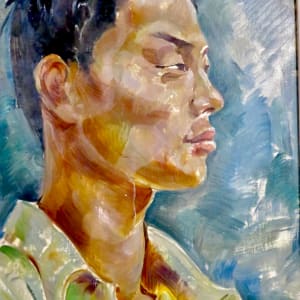
Rita Letendre (1928-2010)
Rita Letendre (1928–2021) was a Canadian painter, muralist, and printmaker associated with Les Automatistes and the Plasticiens. Born in Drummondville, Quebec, of Abenaki and Québécois descent, she studied at the École des beaux-arts de Montréal before embracing abstract art. Influenced by Paul-Émile Borduas, Letendre transitioned from figuration to abstraction, later incorporating geometric elements and hard-edge painting. She gained recognition for her dynamic compositions, large-scale murals, and use of airbrush techniques. Letendre received numerous accolades, including the Order of Canada (2005) and the Governor General’s Award (2010). Her work remains a significant contribution to Canadian modern art.
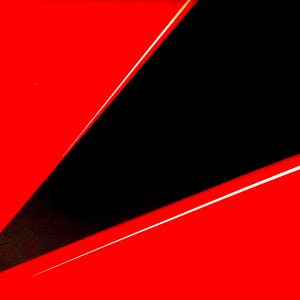
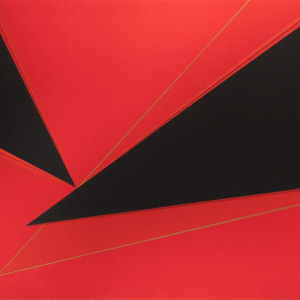
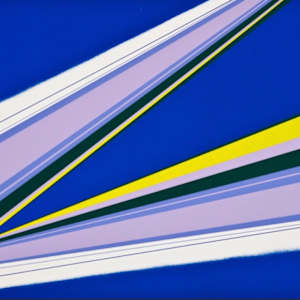
William Darling Mackay
William Darling McKay (1844–1924) was a Scottish painter known for his atmospheric pastoral landscapes. Born in Gifford, McKay studied at the Trustees' Drawing Academy and Royal Scottish Academy School in Edinburgh. Influenced by the Dutch Hague School's en plein air method, he focused on capturing light and atmosphere in rural East Lothian. His works, often depicting men and women working the land, were widely popular. McKay became a member of the Royal Scottish Academy (RSA) in 1883 and contributed to Scottish art through publications and leadership roles. In later life, he served as Librarian and Secretary of the RSA. He passed away in 1924, leaving behind a significant artistic legacy.
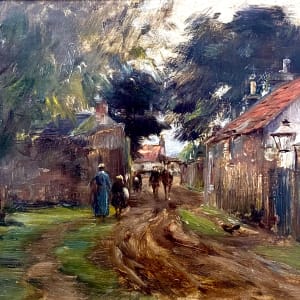
Ronald York Wilson (1907-1984)
York Wilson (1907–1984) was a Canadian painter and muralist known for his transition from social realism to geometric abstraction. Trained at Central Technical School, he began his career as a commercial artist before shifting to fine art in the 1940s.
Wilson’s time in Mexico deeply influenced his work, introducing him to mural techniques and materials such as pyroxylin. His notable murals include those at Toronto’s O’Keefe Centre (now Meridian Hall), the Imperial Oil Building, and the Salvation Army Headquarters. A member of the Royal Canadian Academy of Arts, he also served as president of the Ontario Society of Artists.
His legacy is preserved through the York Wilson Foundation for Visual Arts, which has donated hundreds of his works to public collections.
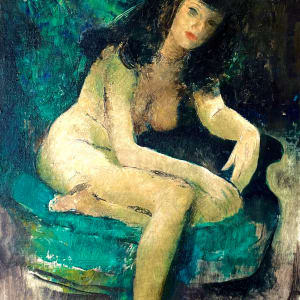
Thomas Mower Martin (1838-1934)
Thomas Mower Martin RCA (1838–1934) was an English-born Canadian landscape painter, often called the "father of Canadian art." Originally trained as a carpenter and draughtsman, he emigrated to Canada in 1862, settling in Toronto after an unsuccessful attempt at farming in Muskoka. Largely self-taught, he became known for his landscapes, portraits, and etchings, working in oils and watercolours. A founding member of the Ontario Society of Artists (1872) and the Royal Canadian Academy of Arts (1880), he was also among the "Railway Painters" commissioned by the Canadian Pacific Railway to document the western frontier. His work is held in public and private collections, including Windsor Castle.
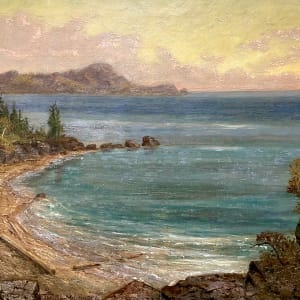
Louis Icart (1888-1950) French
Louis Icart (1888–1950) was a French painter, graphic artist, and illustrator, known for his distinctive Art Deco style. Born in Toulouse, he moved to Paris in 1907 to pursue a career in art, quickly gaining recognition for his fashion sketches and etchings. His work, often featuring sensual depictions of women and glamorous lifestyles, became iconic during the 1920s and 1930s. Icart’s creations, influenced by French masters like Watteau and Boucher, ranged from playful to erotic, blending humor with elegance. He also documented the harsh realities of WWII with a series of poignant works. Icart's legacy includes over 500 engravings and contributions to more than 30 books.
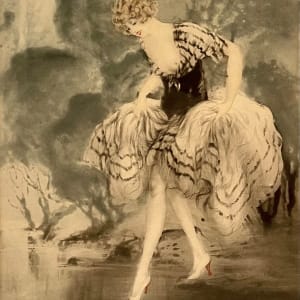
Pablo Picasso (1881-1973) Spanish/French
Pablo Picasso (1881–1973) was a pioneering Spanish artist whose revolutionary contributions to modern art spanned painting, sculpture, ceramics, and printmaking. A master of reinvention, he co-founded Cubism, explored Surrealism, and experimented with Neoclassicism and Expressionism. His early Blue and Rose Periods conveyed themes of melancholy and performance, while his later work, including Les Demoiselles d’Avignon (1907) and Guernica (1937), reshaped artistic conventions. Picasso’s prolific output of over 20,000 works cemented his status as one of the most influential artists of the 20th century, continually pushing artistic boundaries until his death in 1973.
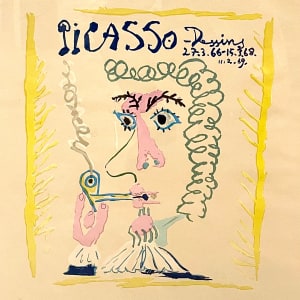
Debora Cardaci
Débora Cardaci is an Argentine-born artist whose creative journey began at a young age, drawing inspiration from her surroundings and travels. With a Fine Arts degree from the National Academy of Fine Arts Prilidiano Pueyrredón in 1992, she went on to teach art for over 20 years, both in her community and at the University of Arts. Her work, deeply influenced by masters like Rodin, Kathe Kollwitz, and the Impressionists, focuses on expressive art that captures motion and emotion.
An accomplished painter, sculptor, illustrator, and designer, Débora’s art is marked by continuous evolution and experimentation with different media. Her works have been exhibited in galleries and are part of private collections across Canada, the U.S., Argentina, Uruguay, Italy, Spain, and the Czech Republic. Currently, she resides in Southern Manitoba, Canada, surrounded by nature, where she continues her artistic exploration.
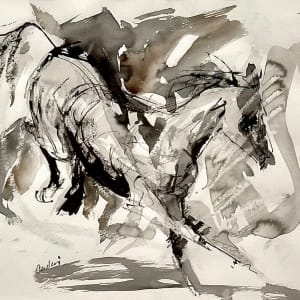
Sanford Fisher
Sanford Fisher (1927–1995) was a self-taught Indigenous artist from the Gordon First Nation in Saskatchewan, Canada. Known for his realist paintings, Fisher captured scenes of family life, farming, hunting, and the prairie landscape, drawing inspiration from his early years on the reserve.
His career took a remarkable turn after an accident led to the amputation of his painting arm. Undeterred, Fisher taught himself to paint with his other hand while still in the hospital, ultimately regaining the skill and style that had made his work so popular.
Resilient and prolific, Fisher continued to paint after relocating to Regina, Saskatchewan, where he remained a beloved figure in the prairie art scene until his passing in 1995.
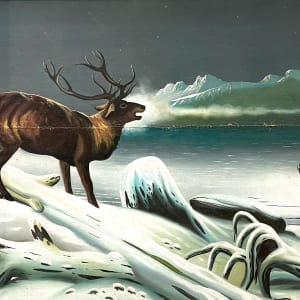
Tom Thomson (1877-1917)
Tom Thomson (1877–1917) was a pioneering Canadian landscape painter and a major influence on the Group of Seven. Born in Claremont, Ontario, he developed a deep connection with Algonquin Park, where he painted many of his most iconic works, including The Jack Pine (1916–17) and The West Wind (1916–17). Thomson’s bold use of colour, dynamic brushwork, and poetic interpretation of nature helped define a uniquely Canadian artistic identity. Despite his brief career—producing about 50 canvases and over 400 sketches—his legacy endures. His mysterious death in Canoe Lake at age 39 has only added to his mythic status in Canadian art.
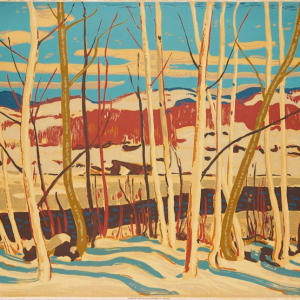
Florence May Campbell
Florence May "Flo" Campbell (née Johnson, 1893–1959) was a Canadian artist known for her landscape oil paintings of the Owen Sound area, including Grey County’s Presque Isle and Balmy Beach. Born into a family of eleven daughters, two of whom, Annie and Agnes, were also artists, Flo was part of the artistic group known as "the painting Johnsons." She married fellow artist Alan Campbell in 1914, and together, they displayed their work at their home in Owen Sound.
Flo served as President of the Lyceum Club and Women's Art Association, where she contributed to the local art scene. A painting by Campbell, depicting a wooded pathway in autumn, was used as a memorial for a local teacher at Dunn's School. After her death, a memorial exhibition of 59 of her works was held in Owen Sound. Her legacy endures through works held in local collections, including the Grey Roots Museum & Archives.
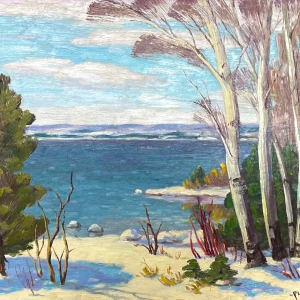
William Ogilvie (1901-1989)
William Abernethy Ogilvie (1901–1989) was a Canadian painter and official Second World War artist. Born in 1901, Ogilvie moved to Canada in 1925 and studied at the Art Students League in New York. In 1933, he co-founded the Canadian Group of Painters. During World War II, he became the first official war artist in 1942, documenting significant war scenes under active combat in Europe, Sicily, and Italy. His wartime works, such as those of Normandy and the Falaise Gap, remain iconic. Post-war, Ogilvie taught at the Ontario College of Art and University of Toronto. He received several honors, including the MBE and was made a member of the Order of Canada in 1979. His works are widely held in national collections, including the Canadian War Museum.
